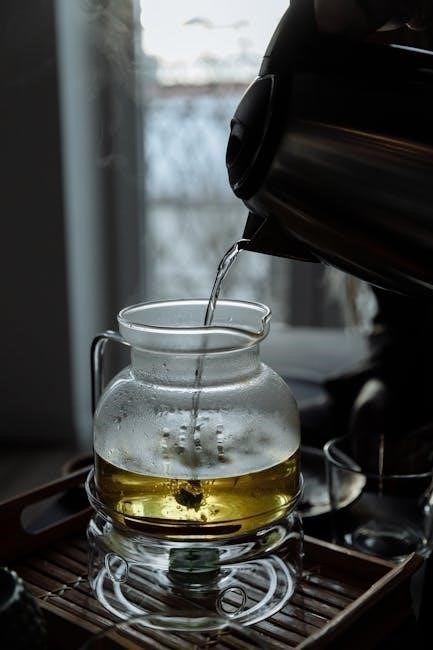A Food Temperature Record Sheet is a crucial tool for tracking and monitoring food temperatures to ensure safety and compliance with health regulations. It helps maintain accurate records for hot and cold food storage, preparing, and serving, using customizable templates like Lumiform’s free food temperature log for daily checks.
What is a Food Temperature Record Sheet?
A Food Temperature Record Sheet is a document used to track and monitor the temperatures of food during storage, preparation, and serving. It ensures that food is maintained at safe temperatures to prevent spoilage and foodborne illnesses. The sheet typically includes fields for recording dates, times, food items, and their respective temperatures. Many templates, such as Lumiform’s free food temperature log, are available for download as PDF files, offering a structured format for accurate and consistent temperature monitoring; This tool is essential for maintaining food safety and compliance with health regulations.
Purpose of a Food Temperature Record Sheet

The primary purpose of a Food Temperature Record Sheet is to ensure food safety by maintaining accurate temperature records. It helps prevent foodborne illnesses by verifying that food is stored, prepared, and served at safe temperatures. The sheet also aids in compliance with health regulations and provides documentation for audits. By using templates like Lumiform’s free food temperature log, businesses can streamline the monitoring process, ensuring consistency and reducing risks. Regular temperature checks are crucial for safeguarding public health and maintaining operational standards in the food industry.

Importance of Food Temperature Record Sheet
A Food Temperature Record Sheet is vital for preventing foodborne illnesses and ensuring compliance with health regulations. It helps maintain safe food storage and serving temperatures, reducing contamination risks. By using templates like Lumiform’s free food temperature log, businesses can ensure accurate monitoring and adhere to legal standards, safeguarding public health and operational integrity.
Food Safety and Preventing Foodborne Illnesses
A Food Temperature Record Sheet is essential for maintaining food safety and preventing foodborne illnesses. By accurately monitoring temperatures, it ensures that potentially hazardous foods are stored and served within safe ranges. Hot foods must be kept above 60°C (140°F), while cold foods should remain below 4°C (40°F). Proper temperature control prevents bacterial growth, reducing the risk of contamination. Using a food temperature log template, like Lumiform’s free PDF, helps track these critical measurements, ensuring compliance with health guidelines and safeguarding consumers from foodborne diseases.
Compliance with Health Regulations
A Food Temperature Record Sheet ensures compliance with health regulations by providing accurate and consistent temperature monitoring. It helps businesses adhere to legal requirements, such as the 2-hour and 4-hour cooling rules for potentially hazardous foods. Regular temperature checks and detailed records serve as legal proof of compliance, reducing the risk of penalties. Templates like Lumiform’s free food temperature log simplify this process, ensuring all food safety standards are met. This documentation is essential for audits and demonstrates a commitment to maintaining safe food handling practices as required by health authorities.

Types of Food Temperature Record Sheets
There are various types of food temperature record sheets, including hot food, cold food, freezer, refrigerator, and cooling food temperature logs.
- Hot Food Temperature Log
- Cold Food Temperature Log
- Freezer Temperature Log
- Refrigerator Temperature Log
- Cooling Food Temperature Log
Hot Food Temperature Log
A Hot Food Temperature Log is used to monitor and record the temperatures of hot foods during preparation and serving. It ensures that hot foods are maintained at a safe temperature, typically above 60°C (140°F), to prevent bacterial growth and foodborne illnesses. This log is essential for spot-checking Temperature Control for Safety (TCS) foods throughout the day. It is often placed near hot food preparation areas for quick access and accurate recording. Regular use of this log helps maintain compliance with health regulations and ensures food safety standards are met consistently.
- Spot-checking hot foods during service
- Ensuring temperatures remain above 60°C (140°F)
- Preventing bacterial growth and foodborne illnesses
- Providing a record for health inspections and audits
Cold Food Temperature Log
A Cold Food Temperature Log is essential for monitoring refrigerated foods, ensuring they are stored at safe temperatures, typically below 4°C (40°F). This log helps prevent bacterial growth and contamination, crucial for maintaining food safety. It is used for recording temperatures of cold food items regularly, especially for potentially hazardous foods. Consistent use of this log ensures compliance with health regulations and provides a clear record for audits. Proper storage and regular checks are vital to safeguarding food quality and consumer health.
- Monitoring refrigerated food temperatures
- Maintaining temperatures below 4°C (40°F)
- Preventing bacterial growth in TCS foods
- Ensuring compliance with safety standards
Freezer Temperature Log
A Freezer Temperature Log is used to monitor and record the temperature of frozen food storage units. It ensures that freezers maintain a consistent temperature, typically below -18°C (0°F), to prevent food spoilage and contamination. Regular checks help maintain food safety and comply with health regulations. This log is crucial for tracking temperature fluctuations over time and addressing any issues promptly. Accurate records are essential for audits and ensuring the quality of stored food products.
- Monitoring freezer temperatures consistently
- Maintaining temperatures below -18°C (0°F)
- Preventing food spoilage and contamination
- Ensuring compliance with food safety standards
Refrigerator Temperature Log
A Refrigerator Temperature Log tracks and records the temperature of refrigeration units to ensure food is stored safely. It is essential for maintaining temperatures below 4°C (40°F) to prevent bacterial growth and foodborne illnesses. Regular checks ensure compliance with health regulations and food safety standards. This log helps identify temperature fluctuations and ensures corrective actions are taken promptly. Accurate records are vital for audits and maintaining the quality of refrigerated food products.
- Monitoring refrigerator temperatures daily
- Maintaining temperatures below 4°C (40°F)
- Preventing bacterial growth in perishable items
- Ensuring compliance with food safety guidelines
Cooling Food Temperature Log
A Cooling Food Temperature Log ensures food cools safely from 60°C to 21°C within 2 hours and from 21°C to 5°C within 4 hours. This log is critical for preventing bacterial growth and maintaining food safety. It records temperature checks at each cooling stage, ensuring compliance with health regulations. Proper cooling prevents foodborne illnesses and extends shelf life. Use templates like Lumiform’s for accurate tracking and to maintain a record of safe cooling practices, essential for audits and ensuring food quality.
- Monitors cooling stages to prevent bacterial growth
- Ensures food cools within safe timeframes
- Prevents foodborne illnesses
- Complies with health and safety standards

How to Create a Food Temperature Record Sheet
Create a Food Temperature Record Sheet by including essential elements like date, time, food items, and temperature readings. Use tools like Lumiform for customizable templates to ensure accuracy and compliance with health standards.
Essential Elements of a Temperature Log
An effective temperature log must include key details such as the date, time, and specific food items being monitored. It should also record the temperature readings for both hot and cold foods, ensuring compliance with safety standards. Additional elements may include the method of temperature measurement and any corrective actions taken if unsafe temperatures are detected. Properly documenting these details helps maintain food safety and prevents potential health risks. Regular updates and accurate entries are vital for a reliable and comprehensive temperature log.
Designing a Customizable Template
A customizable temperature log template should include adjustable fields for date, time, food items, and temperature readings. It should allow users to add specific details such as hot or cold food categories and corrective actions if temperatures fall out of safe ranges. Using tools like Microsoft Excel or Google Sheets, you can create a template with drop-down menus and auto-save features for efficiency. Ensure the template is easy to use and adaptable to different food service settings. Including sections for notes or additional comments can enhance its functionality and compliance with health regulations. A well-designed template streamlines temperature monitoring and ensures accuracy.
Using Pre-Designed Templates
Pre-designed food temperature log templates are convenient and time-saving tools for maintaining accurate records. Lumiform offers a free, comprehensive template for daily temperature checks, ensuring compliance with health regulations. These templates typically include spaces for date, time, food items, and temperature readings, making it easy to monitor hot and cold food storage. Many templates also provide instructions for staff on how to use them effectively. By using pre-designed templates, businesses can ensure consistency and reduce errors in temperature recording. They are often printable and downloadable, making them a practical solution for daily food safety management.

Best Practices for Using a Food Temperature Record Sheet
Use Lumiform’s free template for consistent and accurate temperature checks. Ensure compliance with health regulations and monitor food safety daily with easy-to-use logging tools.
Frequency of Temperature Checks
Regular temperature checks are essential for maintaining food safety. Hot foods should be monitored every 1-2 hours, while cold foods require checks every 4 hours. Freezers and refrigerators must be logged daily to ensure safe storage temperatures (below 4°C/40°F for refrigerators and -18°C/0°F for freezers). Use Lumiform’s free food temperature log template to streamline these processes. Digital tools like Bluetooth-enabled loggers can automate data recording, ensuring consistency and compliance with health regulations. Always document corrective actions if temperatures fall out of safe ranges to prevent foodborne illnesses.
Accurate Recording of Data
Accurate recording of food temperatures is critical for food safety and compliance. Use a food temperature record sheet PDF to log data, including dates, times, and corrective actions. Ensure measurements are precise, with hot foods above 60°C (140°F) and cold foods below 4°C (40°F). Lumiform’s free template helps maintain consistency. Regular audits of temperature logs ensure reliability. Inaccurate records can lead to non-compliance and safety risks. Digital tools, like Bluetooth-enabled loggers, automate data entry, reducing errors and ensuring all information is clear and actionable for food safety management.

Digital Tools for Food Temperature Logging
Utilize software, apps, and Bluetooth-enabled devices to streamline temperature monitoring. Tools like Lumiform offer digital solutions for accurate and efficient food temperature logging, ensuring compliance effortlessly.
Software and Apps for Temperature Monitoring
Software and apps like Lumiform offer digital solutions for temperature monitoring, enabling real-time tracking and automated logging. These tools provide customizable templates, alerts for temperature deviations, and data analytics. They ensure compliance with health regulations and simplify audits. Features include automated data collection, cloud storage, and report generation. Apps like Food Temperature Log and TempLogr allow seamless monitoring of hot and cold storage units. They also support Bluetooth-enabled devices for remote temperature tracking, reducing manual errors and enhancing efficiency in food safety management.
Bluetooth-Enabled Temperature Loggers
Bluetooth-enabled temperature loggers provide seamless wireless monitoring, automating temperature tracking for food safety. These devices connect to software or apps, enabling real-time data transmission and reducing manual errors. They are ideal for hot and cold food storage, ensuring accurate and efficient logging. Many loggers, like those compatible with Lumiform, offer customizable alerts and data analytics. This technology simplifies compliance with health regulations and enhances auditing processes. By integrating with digital tools, Bluetooth loggers streamline temperature monitoring, making food safety management more efficient and reliable for businesses.

Legal and Regulatory Requirements
Adherence to food safety laws mandates accurate temperature monitoring for TCS foods, ensuring compliance with health standards and safe food handling practices to prevent foodborne illnesses.
Understanding Temperature Control for Safety (TCS) Foods
Temperature Control for Safety (TCS) foods require precise monitoring to ensure they remain within safe temperature zones. These foods, such as dairy, meat, and prepared items, must be stored at 40°F (4°C) or below and served at 145°F (63°C) or above. Proper handling prevents bacterial growth, reducing the risk of foodborne illnesses. Using a food temperature record sheet PDF helps track these critical temperatures, ensuring compliance with health regulations and maintaining food safety standards consistently.
Safe Cooling Guidelines
food temperature record sheet PDF to document cooling processes. This ensures compliance with health regulations and food safety standards. Proper cooling methods include using shallow containers and ice baths. Always monitor temperatures during cooling to maintain safety. If food exceeds safe temperature limits, it must be discarded to prevent foodborne illnesses. Regular checks and accurate records are essential for maintaining safe cooling practices.

Common Mistakes to Avoid
Inconsistent temperature checks and incorrect storage temperatures are common errors. Ensure accurate and regular monitoring to prevent foodborne illnesses. Always follow safe cooling guidelines and record data properly.
Inconsistent Temperature Checks
Inconsistent temperature checks are a common mistake that can lead to food safety risks. Irregular monitoring may result in food being stored or served at unsafe temperatures, increasing the risk of foodborne illnesses. It is essential to conduct temperature checks at regular intervals, as specified by health regulations, to ensure compliance and safety. Using tools like Lumiform’s free food temperature log template can help maintain consistency and accuracy in recording temperatures. Always prioritize regular checks to prevent potential hazards and ensure food safety standards are met consistently.
Incorrect Storage Temperatures
Incorrect storage temperatures pose significant risks to food safety. Storing food at improper temperatures can lead to bacterial growth, making food unsafe for consumption; Refrigerators should be set at 40°F (4°C) or below, while freezers should be at 0°F (-18°C) or below. Failure to maintain these temperatures can result in foodborne illnesses. To prevent this, ensure all storage units are regularly checked and recorded using a food temperature record sheet. Additionally, always follow the 2-hour and 4-hour cooling rules for potentially hazardous foods to maintain safety standards. Downloadable templates, like Lumiform’s, can help ensure accurate temperature tracking and compliance with health guidelines. Always verify storage temperatures to avoid unsafe conditions and protect consumer health.

Additional Resources and Templates
Access free downloadable food temperature record sheet templates online, including hot, cold, freezer, and refrigerator logs. Find templates for the 2-hour/4-hour rule and cooling guidelines. Download now and ensure compliance with food safety standards using these resources.
Free Downloadable Templates
Various free food temperature record sheet templates are available online, offering customizable solutions for tracking food safety. Lumiform provides a comprehensive food temperature log template for daily checks, ensuring compliance with health regulations. Download templates for hot food, cold food, freezer, and refrigerator logs. Additionally, find templates for the 2-hour/4-hour rule and cooling guidelines. These resources are user-friendly and professionally designed to streamline temperature monitoring processes, ensuring food safety and regulatory adherence. Access these templates now and maintain precise records effortlessly.
Guidelines for Food Temperature Monitoring
Effective food temperature monitoring ensures food safety and prevents foodborne illnesses. Always maintain hot foods above 60°C (140°F) and cold foods at or below 4°C (40°F). Regularly check temperatures of refrigerators and freezers, ensuring they operate at 4°C (40°F) and -18°C (0°F), respectively. Document temperatures at least twice daily for refrigerators and once daily for freezers. For cooling, hazardous foods must cool from 60°C to 21°C within 2 hours and to 5°C within 4 hours. Use a food temperature record sheet to log these checks and maintain records for compliance and audits.
